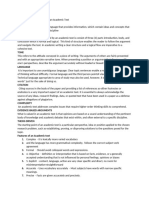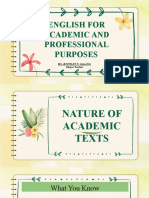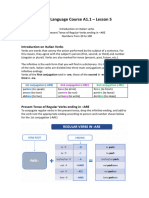Eapp Handout 1
Eapp Handout 1
Uploaded by
Kerly Martinez VargasCopyright:
Available Formats
Eapp Handout 1
Eapp Handout 1
Uploaded by
Kerly Martinez VargasOriginal Title
Copyright
Available Formats
Share this document
Did you find this document useful?
Is this content inappropriate?
Copyright:
Available Formats
Eapp Handout 1
Eapp Handout 1
Uploaded by
Kerly Martinez VargasCopyright:
Available Formats
ENGLISH FOR ACADEMIC AND PROFESSIONAL PURPOSES
HANDOUT #1: READING ACADEMIC TEXTS
LESSON 1: Academic Language used from Various Disciplines
Nature and Characteristics of an Academic Text
An academic text is a written language that provides information, which contain ideas
and concepts that are related to the particular discipline. Essay, Research Paper, Report,
Project, Article, Thesis, and Dissertation are considered as academic texts.
Structure
The basic structure that is used by an academic text is consist of three (3) parts
introduction, body, and conclusion which is formal and logical.
Tone
This refers to the attitude conveyed in a piece of writing.
Language
It is important to use unambiguous language. Clear topic sentences enable a reader to
follow your line of thinking without difficulty. Formal language and the third person point-
of-view should be used.
Citation
Citing sources in the body of the paper and providing a list of references as either footnotes
or endnotes is a very important aspect of an academic text.
Complexity
An academic text addresses complex issues that require higher-order thinking skills to
comprehend.
Evidence-based Arguments
What is valued in an academic text is that opinions are based on a sound understanding
of the pertinent body of knowledge and academic debates that exist within, and often
external to a specific discipline.
Thesis-driven
The starting point of an academic text is a particular perspective, idea or position
applied to the chosen research problem, such as establishing, proving, or disproving
solutions to the questions posed for the topic.
Features of Academic Texts:
1. Complex
- Written language has no longer words, it is lexically more varied vocabulary.
- Written texts are shorter and the language has more grammatical complexity,
including more subordinate clauses and more passives.
2. Formal
- Should avoid colloquial words and expressions.
3. Precise
- Facts are given accurately and precisely.
4. Objective
- has fewer words that emphasize on the information you want to give and the
arguments you want to make
- mostly use nouns (adjectives), rather than verbs (adverbs)
1|Page Prepared by: Mrs. Rose Jane B. Aves
5. Explicit
- It is the responsibility of the writer in English to make it clear to the reader how
the various parts of the text are related.
6. Accurate
- Uses vocabulary accurately
- Most subjects have words with narrow specific meanings.
7. Hedging
- It is necessary to make decisions about your stance on a particular subject, or
the strength of the claims you are making.
8. Responsible
- You must be responsible for and must be able to provide evidence and
justification for any claims you make.
9. Organize
- Well-organized.
- It flows easily from one section to the next in a logical fashion.
10. Plan
- Well-planned.
- It usually takes place after research and evaluation, according to specific
purpose and plan.
Purposes in Reading an Academic Text
1. To locate a main idea;
2. To scan for information;
3. To identify gaps in existing studies;
4. To connect new ideas to existing ones;
5. To gain more pieces of information;
6. To support a particular writing assignment; and,
7. To deeply understand an existing idea.
Factors to Consider in Writing Academic Text
1.State critical questions and issues;
2. Provide facts and evidence from credible sources;
3. Use precise and accurate words while avoiding jargon;
4. Take an objective point of view;
5. List references; and,
6. Use cautious language.
Non academic texts include writings that are informal and dedicated to a lay audience.
Articles, e-mail messages, text messages, journal writing, and letters are some examples of
nonacademic text.
Academic and Social Language
Academic language is the language needed by students to do the work in schools. It
includes, for example, discipline-specific vocabulary, grammar and punctuation, and
applications of rhetorical conventions and devices that are typical for a content area .
Social language is the set of vocabulary that allows us to communicate with others in the
context of regular daily conversations.
2|Page Prepared by: Mrs. Rose Jane B. Aves
Characteristics of Academic Language
A. Formal - It should not sound conversational or casual. Colloquial, idiomatic, slang or
journalistic expressions should particularly be avoided.
B. Objective - This means it is unbiased. It should be based on facts and evidence and
are not influenced by personal feelings.
C. Impersonal - This involves avoiding the personal pronouns ‘I’ and ‘we’. For example,
instead of writing ‘I will show’, you might write ‘this report will show’. The second person,
‘you’, is also to be avoided.
LESSON 2: Text Structure
Text structures (WDPI, 2012) refer to the way authors organize information in text.
Recognizing the underlying structure of texts can help students focus attention on key
concepts and relationships, anticipate what is to come, and monitor their comprehension
as they read.
COMMON TEXT STRUCTURES
3|Page Prepared by: Mrs. Rose Jane B. Aves
4|Page Prepared by: Mrs. Rose Jane B. Aves
Why is Text Structure Important?
The readers can significantly improve their comprehension and retention of information
when they can identify and recognize the text structure of a text. It can also help them:
1. Organize information and details they are learning in their minds while reading.
2. Make connections between the details being presented in a text
3. Summarize the important details shared in a text
Lesson 3: Techniques in Summarizing Variety of Academic Texts
Summarizing is how we take larger selections of text and reduce them to their bare
essentials: the gist, the key ideas, the main points that are worth noting and remembering.
Webster's calls a summary the "general idea in brief form"; it's the distillation,
condensation, or reduction of a larger work into its primary notions. (“Reading Quest
Strategies | Summarizing”)
Basic Rules:
A. Erase things that don’t matter. Delete trivial material that is unnecessary to
understanding.
B. Erase things that repeat. Delete redundant material. In note taking, time and
space is precious. If a word or phrase says basically the same thing you have
already written down, then don’t write it again!
C. Trade, general terms for specific names. Substitute superordinate terms for lists
(e.g., flowers for daisies, tulips for roses). Focus on the big picture. Long, technical
lists are hard to remember. If one word will give you the meaning, then less is more.
D. Use your own words to write the summary. Write the summary using your own
words but make sure to retain the main points.
Techniques:
1. Somebody Wanted But So. The strategy helps students generalize, recognize cause
and effect relationships, and find main ideas.
5|Page Prepared by: Mrs. Rose Jane B. Aves
After answering the questions, combine the answers to form a summary:
Little Red Riding Hood wanted to take cookies to her sick grandmother, but she
encountered a wolf. He got to her grandmother’s house first and pretended to be the old
woman. He was going to eat Little Red Riding Hood, but she realized what he was doing
and ran away, crying for help. A woodsman heard the girl’s cries and saved her from the
wolf.
2. SAAC Method. This method is particularly helpful in summarizing any kind of text.
SAAC is an acronym for “State, Assign, Action, Complete.” Each word in the acronym
refers to a specific element that should be included in the summary.
Use the four SAAC cues to write out a summary of "The Boy Who Cried Wolf" in complete
sentences:
"The Boy Who Cried Wolf," by Aesop (a Greek storyteller), tells what happens when a
shepherd boy repeatedly lies to the villagers about seeing a wolf. After a while, they ignore
his false cries. Then, when a wolf really does attack, they don’t come to help him.
3. 5 W's, 1 H. This technique relies on six crucial questions: who, what, when where, why,
and how. These questions make it easy to identify the main character, important details,
and main idea.
6|Page Prepared by: Mrs. Rose Jane B. Aves
4. First Then Finally. This technique helps students summarize events in chronological
order.
First: What happened first? Include the main character and main event/action.
Then: What key details took place during the event/action?
Finally: What were the results of the event/action?
Here is an example using "Goldilocks and the Three Bears."
First, Goldilocks entered the bears' home while they were gone. Then, she ate their food, sat
in their chairs, and slept in their beds. Finally, she woke up to find the bears watching her,
so she jumped up and ran away.
5. Give Me the Gist. This type of techniques is like giving a friend the gist of a story. In
other words, they want a summary – not a retelling of every detail.
7|Page Prepared by: Mrs. Rose Jane B. Aves
You might also like
- SAMPLE Grammar and Beyond Essentials 1Document20 pagesSAMPLE Grammar and Beyond Essentials 1derin50% (2)
- Examberry English Papers 1-4 AnswersDocument10 pagesExamberry English Papers 1-4 Answerspantmukul33% (3)
- Lecture 5. CoherenceDocument18 pagesLecture 5. Coherencekamilaabyl59No ratings yet
- English 10 - Quarter 2 - Module 7Document8 pagesEnglish 10 - Quarter 2 - Module 7Emilio Villafria IV67% (3)
- First Periodical Test in English 3Document4 pagesFirst Periodical Test in English 3Anonymous ZLS4QBxT100% (10)
- Soft Copy Eapp Lesson 1 3Document6 pagesSoft Copy Eapp Lesson 1 3xigebo7666No ratings yet
- Lesson 01: Differentiates Language Used in Academic Texts From Various DisciplinesDocument57 pagesLesson 01: Differentiates Language Used in Academic Texts From Various DisciplinesShirley D. Capili LptNo ratings yet
- Lesson 0 1: Differentiates Language Us Ed in Academic Texts From Various Dis CiplinesDocument57 pagesLesson 0 1: Differentiates Language Us Ed in Academic Texts From Various Dis CiplinesRamona ViernesNo ratings yet
- Reading Academic TextDocument52 pagesReading Academic TextMeepNo ratings yet
- Lesson 01: Differentiates Language Used in Academic Texts From Various DisciplinesDocument57 pagesLesson 01: Differentiates Language Used in Academic Texts From Various DisciplinesEVA MAE BONGHANOYNo ratings yet
- LAS EAPP12 Q1W1 RemovedDocument14 pagesLAS EAPP12 Q1W1 RemovedcortezmikhielajaneNo ratings yet
- Eapp - Lesson 2 - Academic LanguageDocument60 pagesEapp - Lesson 2 - Academic LanguageJames Alexander DezaNo ratings yet
- Inbound 8154553630732892593Document125 pagesInbound 8154553630732892593Kyzelle PalapasNo ratings yet
- EAPPG11 q1 - Mod1 Reading-For-Acadtext v2-2Document9 pagesEAPPG11 q1 - Mod1 Reading-For-Acadtext v2-2Nicole BernardoNo ratings yet
- EAPP ReviewerDocument17 pagesEAPP ReviewerkimviaNo ratings yet
- English NotesssssssDocument11 pagesEnglish NotesssssssLUCIA PELAYONo ratings yet
- Easp Q1 W1Document42 pagesEasp Q1 W1quandtshoNo ratings yet
- Prototype Lesson Plan ENGLISH10 Q3 WK3Document9 pagesPrototype Lesson Plan ENGLISH10 Q3 WK3Lyke Therese Sungahid - BagsacNo ratings yet
- Eapp Q1 M1Document3 pagesEapp Q1 M1Crystal Maye LausaNo ratings yet
- English: Quarter 4 - Module 1Document26 pagesEnglish: Quarter 4 - Module 1gerlie maeNo ratings yet
- REVIEWER EAPP (Monthly Exam)Document5 pagesREVIEWER EAPP (Monthly Exam)dbaldedomar.padriquezNo ratings yet
- Unit 1Document24 pagesUnit 1Jasper TaoctaNo ratings yet
- Eapp NotesDocument7 pagesEapp Notesasadasaf401No ratings yet
- Q1 PointersDocument6 pagesQ1 Pointersrizonarchelyn786No ratings yet
- EAPP-Reviewer 2Document5 pagesEAPP-Reviewer 2n5ct996hgdNo ratings yet
- Eapp Module LongDocument41 pagesEapp Module Longellorinmymae17No ratings yet
- English For Academic Teachers Made 1-3Document51 pagesEnglish For Academic Teachers Made 1-3Ken FerrolinoNo ratings yet
- EnglishDocument56 pagesEnglishm84121798No ratings yet
- ReviewerDocument8 pagesRevieweraaronmarimla81No ratings yet
- FH - Academic Paragraph - Ladesi Henita PDFDocument14 pagesFH - Academic Paragraph - Ladesi Henita PDFladesiNo ratings yet
- EAPP Reviewer Q1Document5 pagesEAPP Reviewer Q1HUMSS filesNo ratings yet
- Q1-Lesson 1 - Nature of Academic TextsDocument32 pagesQ1-Lesson 1 - Nature of Academic TextsB BNo ratings yet
- Eapp FirstlessonDocument26 pagesEapp FirstlessonRosales Keian G.No ratings yet
- Lesson 1 Academic Language Used From Various DisciplinesDocument27 pagesLesson 1 Academic Language Used From Various Disciplineschen11ogalescoNo ratings yet
- AENG ReviewerDocument6 pagesAENG ReviewerShekinah HechanovaNo ratings yet
- Academic Writing HandoutsDocument6 pagesAcademic Writing HandoutsJudelyn AndanarNo ratings yet
- Academic Writing Presantation PowerPointDocument58 pagesAcademic Writing Presantation PowerPointkundayi shavaNo ratings yet
- Eapp - Module 1 - Lesson 1Document50 pagesEapp - Module 1 - Lesson 1Rio Fionah LopezNo ratings yet
- What Is The Structure of Academic TextDocument13 pagesWhat Is The Structure of Academic Textjanice curagNo ratings yet
- Eapp Week 4Document10 pagesEapp Week 4Roi Vincent Cuaresma BlasNo ratings yet
- Eapp Week 1Document57 pagesEapp Week 1Angelyn TrinidadNo ratings yet
- DLP English 7 Quarter 4 Week 1 Final D3 5Document5 pagesDLP English 7 Quarter 4 Week 1 Final D3 5Elvira InocNo ratings yet
- EappDocument9 pagesEappgaeNo ratings yet
- Eapp 11 NotesDocument6 pagesEapp 11 Notesemee rose marcellaNo ratings yet
- Eapp Lesson 1 7Document22 pagesEapp Lesson 1 7Deither PitasNo ratings yet
- Q3 - 2 - Academic Language Used From Various DisciplinesDocument60 pagesQ3 - 2 - Academic Language Used From Various DisciplineshaydeeNo ratings yet
- Eapp Month 1Document62 pagesEapp Month 1ᜃᜎᜐ᜔ᜆᜒ100% (1)
- Omprehension Riting: Rules To Read & Attempt A Comprehension Passage An Exemplary PassageDocument10 pagesOmprehension Riting: Rules To Read & Attempt A Comprehension Passage An Exemplary PassageRabi ChaudhryNo ratings yet
- Course Outline For Efapp: UNIT 1.1 Fundamentals of Reading Academic Texts A. Four Macro Skills in English CommunicationDocument5 pagesCourse Outline For Efapp: UNIT 1.1 Fundamentals of Reading Academic Texts A. Four Macro Skills in English CommunicationKIM LABRADOR - GALENDEZNo ratings yet
- ENG7 L1 4thQDocument28 pagesENG7 L1 4thQLovie DumpNo ratings yet
- Eapp Q3 Week-4Document30 pagesEapp Q3 Week-4Jackelyn PangilinanNo ratings yet
- Critical Journal Book: Course Materials For Reading 1Document11 pagesCritical Journal Book: Course Materials For Reading 1ripihamdaniNo ratings yet
- Academic Language Used From Various Disciplines.Document18 pagesAcademic Language Used From Various Disciplines.JoelynBitosNo ratings yet
- Insam Level 2, EnglishDocument50 pagesInsam Level 2, EnglishEkobe blaiseNo ratings yet
- Lesson 2 EappDocument15 pagesLesson 2 Eappsaturinas.136539142065No ratings yet
- Summarizing Your Text: Write An Accurate SummaryDocument4 pagesSummarizing Your Text: Write An Accurate SummarymacjeromemanuelNo ratings yet
- Module 9Document7 pagesModule 9Jerome BautistaNo ratings yet
- C1M L1a Reading Academic Text - G1Document12 pagesC1M L1a Reading Academic Text - G1Joseph VasquezNo ratings yet
- Unit Topic 1: Reading Academic Texts: Learning CompetenciesDocument27 pagesUnit Topic 1: Reading Academic Texts: Learning Competenciesjoshua pagadoan100% (1)
- Module 1 - Lesson 1 Academic TextDocument21 pagesModule 1 - Lesson 1 Academic TextTIMOTHYDELUSOALLISANDRANo ratings yet
- EAPPDocument12 pagesEAPPAlejandro SantosNo ratings yet
- Notes 1 THE STRUCTURE OF ACADEMIC TEXTDocument49 pagesNotes 1 THE STRUCTURE OF ACADEMIC TEXTjayannbacanto15No ratings yet
- Eng7 q4 w1 Studentsversion v2Document10 pagesEng7 q4 w1 Studentsversion v2VictorNo ratings yet
- Subject - Verb AgreementDocument11 pagesSubject - Verb AgreementJethro Apolinar BaladingNo ratings yet
- AdverbsDocument50 pagesAdverbsmagnumsilentium100% (2)
- Prezentul 20200409 0001Document6 pagesPrezentul 20200409 0001Ciprian PetcuNo ratings yet
- Detailed Lesson Plan in English I. ObjectivesDocument3 pagesDetailed Lesson Plan in English I. ObjectivesJenefer Tunares100% (1)
- Hall-2002-Unnatural Gender in Hindi PDFDocument30 pagesHall-2002-Unnatural Gender in Hindi PDFAkil LawyerNo ratings yet
- Pages - 33, 35 (Page 33 Vocab. Exercise 6, Page 35 Exam Spot Exercises 4-6)Document2 pagesPages - 33, 35 (Page 33 Vocab. Exercise 6, Page 35 Exam Spot Exercises 4-6)Steven0% (1)
- 3 EnglishDocument4 pages3 EnglishKashaf BatoolNo ratings yet
- Easy English GrammarDocument89 pagesEasy English GrammarIftikhar Hussain Rizvi100% (4)
- SimplesentenceoverheadDocument33 pagesSimplesentenceoverheadEmerito PerezNo ratings yet
- Conditionals Theory and ChartDocument2 pagesConditionals Theory and ChartMaRieNo ratings yet
- Future TensesDocument10 pagesFuture TensesCira Fernandez SanchezNo ratings yet
- Italian A1.1 - Lesson NotesDocument3 pagesItalian A1.1 - Lesson NotesEli BiNo ratings yet
- Grammar - Verb To BEDocument4 pagesGrammar - Verb To BEJHON WILSON CUSI LUQUENo ratings yet
- English IIDocument63 pagesEnglish IIdaniela alegriaNo ratings yet
- Sentential Semantics 1Document16 pagesSentential Semantics 1BeautifulNo ratings yet
- Pasttense - Kelompok 2Document6 pagesPasttense - Kelompok 2Kang RyanNo ratings yet
- Function of Noun PhrasesDocument7 pagesFunction of Noun PhrasesCharlota PelNo ratings yet
- English Lesson Plan Year 5 TemplateDocument2 pagesEnglish Lesson Plan Year 5 TemplateHaiqal IskandarNo ratings yet
- Adjective 1Document6 pagesAdjective 1Preeti KatiyarNo ratings yet
- Modal Verbs Functions: Grammar Notes AdjectivesDocument5 pagesModal Verbs Functions: Grammar Notes AdjectivesEdward N MichealNo ratings yet
- WWW - Tnstudy.in - English Grammer MaterialsDocument14 pagesWWW - Tnstudy.in - English Grammer Materialskuthubudeen_tm90No ratings yet
- Adjective ComplementDocument2 pagesAdjective ComplementArya Stark0% (1)
- M.T Curriculum AuditDocument6 pagesM.T Curriculum Auditarmand resquir jrNo ratings yet
- SIS Italian Course A2 Program PDFDocument8 pagesSIS Italian Course A2 Program PDFRegraguiLachhabNo ratings yet
- English II Homework Module 3Document4 pagesEnglish II Homework Module 3Ronald Josue Osorto PazNo ratings yet
- Computer-Aided Translation Technology A Practical Introduction (Lynne Bowker) (Z-Lib - Org) - 115-117Document3 pagesComputer-Aided Translation Technology A Practical Introduction (Lynne Bowker) (Z-Lib - Org) - 115-117Abdulaziz khuninNo ratings yet

























































































